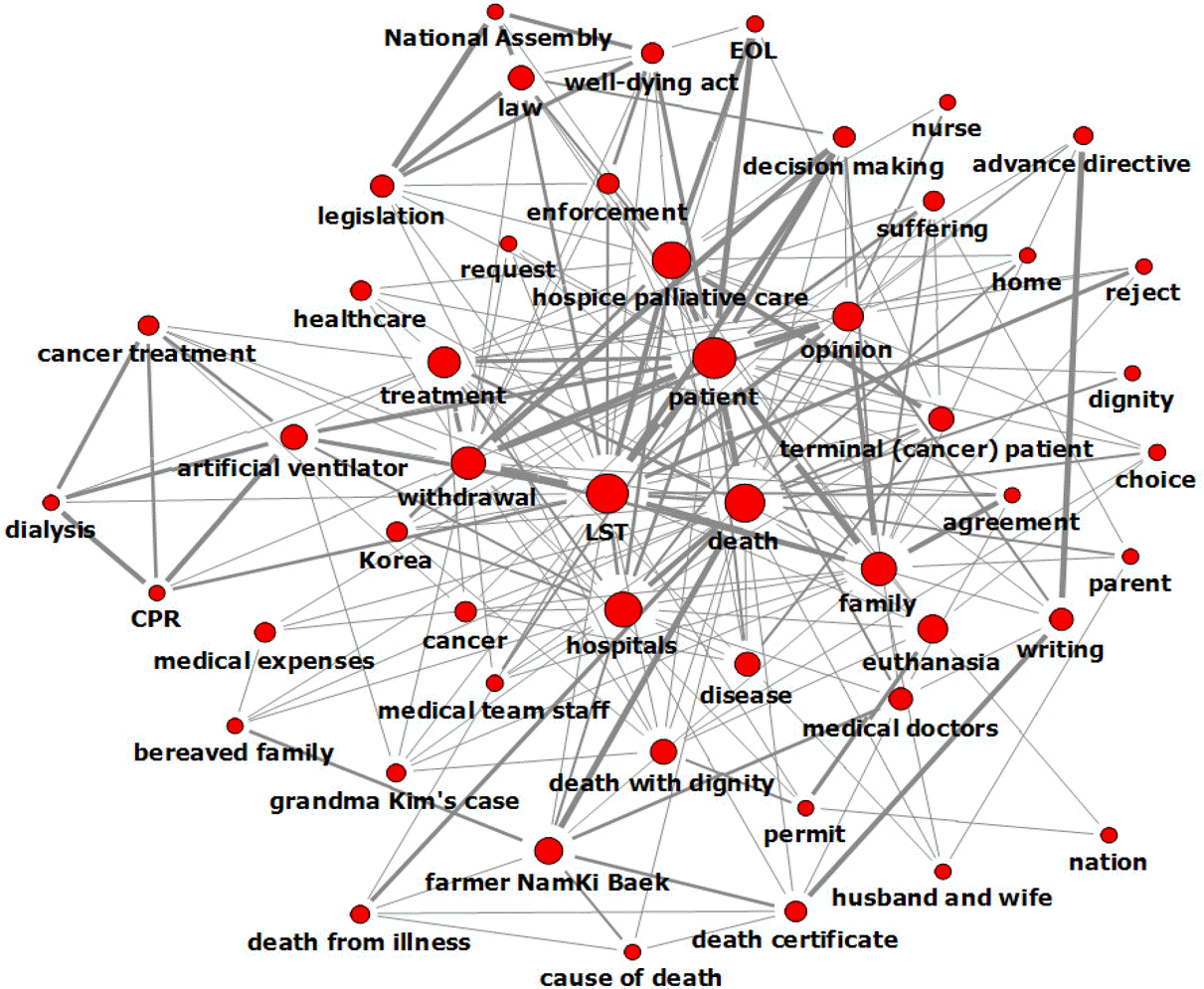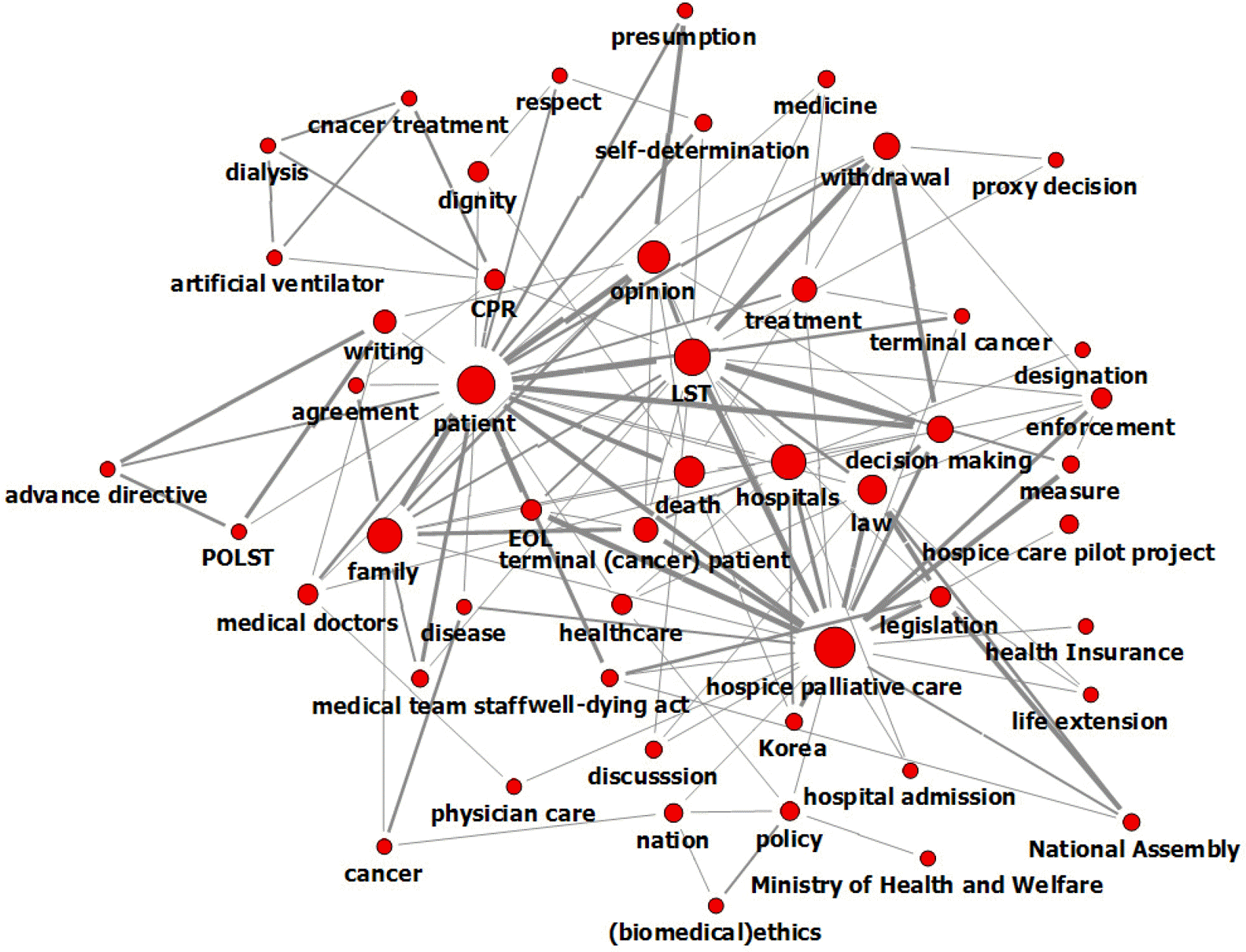Abstract
Purpose
This study tried to understand discourses of life-sustaining treatments in general daily and healthcare newspapers.
Methods
A text-network analysis was conducted using the NetMiner program. Firstly, 572 articles from 11 daily newspapers and 258 articles from 8 healthcare newspapers were collected, which were published from August 2013 to October 2016. Secondly, keywords (semantic morphemes) were extracted from the articles and rearranged by removing stop-words, refining similar words, excluding non-relevant words, and defining meaningful phrases. Finally, co-occurrence matrices of the keywords with a frequency of 30 times or higher were developed and statistical measures―indices of degree and betweenness centrality, ego-networks, and clustering―were obtained.
Results
In the general daily and healthcare newspapers, the top eight core keywords were common: “patients,” “death,” “LST (life-sustaining treatments),” “hospice palliative care,” “hospitals,” “family,” “opinion,” and “withdrawal.” There were also common subtopics shared by the general daily and healthcare newspapers: withdrawal of LST, hospice palliative care, National Bioethics Review Committee, and self-determination and proxy decision of patients and family. Additionally, the general daily newspapers included diverse social interest or events like well-dying, euthanasia, and the death of farmer Baek Nam-ki, whereas the healthcare newspapers discussed problems of the relevant laws, and insufficient infrastructure and low reimbursement for hospice-palliative care.
Go to : 
References
1. Heo DS. End-of-life decision in Korea. Journal of Korean Medical Association. 2008; 51(6):524–529. https://doi.org/10.5124/jkma.2008.51.6.524.

2. National Law Information Center. Removal of meaningless survival devices, etc [Internet]. Sejong: Korea Ministry of Government Legislation;2009. [cited 2018 March 12]. Available from:. http://www.law.go.kr/%ED%8C%90%EB%A1%80/(2009%EB%8B%A417417).
3. National Law Information Center. Law on hospice and palliative care utilization and life-sustaining treatment decision mak- ing of patients at the end-of-life [Internet]. Sejong: Korea Ministry of Government Legislation;2016. [cited 2017 November 18]. Available from:. http://www.law.go.kr.
4. Brown BA. The history of advance directives a literature review. Journal of Gerontological Nursing. 2003; 29(9):4–9. https://doi.org/10.3928/0098-9134-20030901-04.

5. Khandelwal N, Kross EK, Engelberg RA, Coe NB, Long AC, Curtis JR. Estimating the effect of palliative care interventions and advance care planning on ICU utilization: A systematic review. Critical Care Medicine. 2015; 43(5):1102–1111. https://doi.org/10.1097/CCM.0000000000000852.
6. Lee IY. Social implication of living wills, advance directives and natural death act in Korea. The Korean Society of Law and Medicine. 2008; 9(1):413–460.
7. Oh EH. A study on the end-of-life care and healthcare costs in Japan. The Korean Society of Law and Medicine. 2009; 10(1):307–322.
8. Lee IY. A comparative legal review on the characteristics of the law on life-sustaining treatment decision making [Internet]. Seoul: Korea National Institute For Bioethics Policy;2016. [cited 2018 March 6]. Available from:. http://nibp.kr/news/2016_01/2016_01_01.pdf.
9. Lee SB. Issues and tasks of the sog. Well-dying act. Kookmin Law Review. 2017; 29(3):311–340. https://doi.org/10.17251/legal.2017.29.3.311.
10. Korean Society for Hospice and Palliative Care. Notice: Joint statement of patient end-of-life decision act [Internet]. Seoul: Author;2017. [cited 2017 September 11]. Available from:. http://www.hospicecare.or.kr/.
11. Koh CK, Ko CM, Park HY. Critical care nurses' perception of life-sustaining treatment at end of life: A content analysis. Journal of Korean Critical Care Nursing. 2017; 10(1):41–50.
12. Division of Bioethics Policy. The full-fledged health care decision system [Internet]. Sejong: Ministry of Health and Welfare;2018. [cited 2018 March 13]. Available from:. http://www.mohw.go.kr/react/al/sal0301vw.jsp?PAR_MENU_ID=04&MENU_ID=0403&page=8&CONT_SEQ=343672.
13. Park ET. Initial confusion in implementing "Act on decision on life-sustaining treatment for patients in hospice and palliative care or at the end of life", requiring further revision is necessary. Medipana News. 2018; February 26 [cited 2018 March 13]. Available from:. http://www.medipana.com/news/news_viewer.asp?NewsNum=216318&MainKind=A&NewsKind=61&vCount=12&vKind=1.
14. Choi YJ, Kweon SH. A semantic network analysis of the newspaper articles on Big data. Journal of Cyber Communication Academic Society. 2014; 31(1):241–286.
15. Lee SJ, Kim HY. Attitude, role perception and nursing stress on life sustaining treatment among intensive care unit nurses. Korean Journal of Adult Nursing. 2017; 29(2):131–142. https://doi.org/10.7475/kjan.2017.29.2.131.

16. Lee SS. Network analysis methods. Seoul: Nonhyeong;2012. p. 370.
17. Wasserman S, Faust K. Social Network Analysis: Methods and Applications. New York, USA: Cambridge University Press;1994. p. 801.
18. Korea Audit Bureau of Certification. 2017 daily newspapers paid circulation (2017.11.22.) [Internet]. Seoul: Korea Audit Bureau of Certification Association;2011. [cited 2018 June 04]. Available from:. http://www.kabc.or.kr/about/notices/100000002541?param.page=¶m.category=¶m.keyword=.
19. Park EJ, Cho SZ. KoNLPy: Korean natural language processing in Python. Paper presented at: The 26th Annual Conference on Human & Cognitive Language Technology. 2014. October 10-11; Kangwon National University. Chuncheon.
20. Cyram. NetMiner. Version 4.3 [software]. Seoul: Cyram Inc;2000. [cited 2017 July 28]. Available from:. http://www.netminer.com/main/main-read.do.
21. Park EJ, Kim YJ, Park CS. A comparison of hospice care research topics between Korea and other countries using text network analysis. Journal of Korean Academy of Nursing. 2017; 47(5):600–612. https://doi.org/10.4040/jkan.2017.47.5.600.

22. Brown PF, Desouza PV, Mercer RL, Pietra VJD, Lai JC. Class-based n-gram models of natural language. Computational Linguistics. 1992; 18(4):467–479.
23. Park C, Jung C. Text network analysis: Detecting shared meaning through socio-cognitive networks of policy stakeholders. Journal of Governmental Studies. 2013; 19(2):73–108.
24. Paranyushkin D. Identifying the pathways for meaning circulation using text network analysis [Internet]. Berlin: Nodus Labs;2011. [cited 2017 August 20]. Available from:. http://noduslabs.com/research/pathways-meaning-circulation-text-network-analysis.
25. Newman ME. Modularity and community structure in networks. Proceedings of the National Academy of Sciences of the United States of America. 2006; 103(23):8577–8582. https://doi.org/10.1073/pnas.0601602103.

Go to : 
 | Figure 2.Sociogram of the top 50 keywords based on degree-centrality in general daily newspaper articles on life-sustaining treatments (LST). |
 | Figure 3.Sociogram of the top 50 keywords based on degree-centrality in healthcare newspaper articles on life-sustaining treatments (LST). |
Table 1.
The Top 30 Keywords by Centrality Index in General Daily Newspaper Articles on Life-sustaining Treatments (LST)
Table 2.
The Top 30 Keywords by Centrality Index in Healthcare Newspaper Articles on Life-sustaining Treatments (LST)




 PDF
PDF ePub
ePub Citation
Citation Print
Print



 XML Download
XML Download